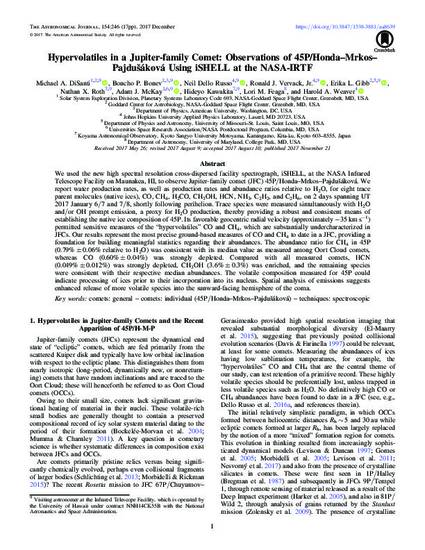
Article
Hypervolatiles in a Jupiter-Family Comet: Observations of 45P/Honda–Mrkos–Pajdušáková Using iSHELL at the NASA-IRTF
The Astronomical Journal
(2017)
Abstract
We used the new high spectral resolution cross-dispersed facility spectrograph, iSHELL, at the NASA Infrared Telescope Facility on Maunakea, HI, to observe Jupiter-family comet (JFC) 45P/Honda–Mrkos–Pajdušáková. We report water production rates, as well as production rates and abundance ratios relative to H2O, for eight trace parent molecules (native ices), CO, CH4, H2CO, CH3OH, HCN, NH3, C2H2, and C2H6, on 2 days spanning UT 2017 January 6/7 and 7/8, shortly following perihelion. Trace species were measured simultaneously with H2O and/or OH prompt emission, a proxy for H2O production, thereby providing a robust and consistent means of establishing the native ice composition of 45P. Its favorable geocentric radial velocity (approximately −35 km s−1) permitted sensitive measures of the "hypervolatiles" CO and CH4, which are substantially undercharacterized in JFCs. Our results represent the most precise ground-based measures of CO and CH4 to date in a JFC, providing a foundation for building meaningful statistics regarding their abundances. The abundance ratio for CH4 in 45P (0.79% ± 0.06% relative to H2O) was consistent with its median value as measured among Oort Cloud comets, whereas CO (0.60% ± 0.04%) was strongly depleted. Compared with all measured comets, HCN (0.049% ± 0.012%) was strongly depleted, CH3OH (3.6% ± 0.3%) was enriched, and the remaining species were consistent with their respective median abundances. The volatile composition measured for 45P could indicate processing of ices prior to their incorporation into its nucleus. Spatial analysis of emissions suggests enhanced release of more volatile species into the sunward-facing hemisphere of the coma.
Disciplines
Publication Date
November 21, 2017
DOI
10.3847/1538-3881/aa8639
Citation Information
Michael A. DiSanti, Boncho P. Bonev, Neil Dello Russo, Ronald J. Vervack, et al.. "Hypervolatiles in a Jupiter-Family Comet: Observations of 45P/Honda–Mrkos–Pajdušáková Using iSHELL at the NASA-IRTF" The Astronomical Journal Vol. 154 Iss. 6 (2017) p. 246 - 262 Available at: http://works.bepress.com/erika-gibb/1/
